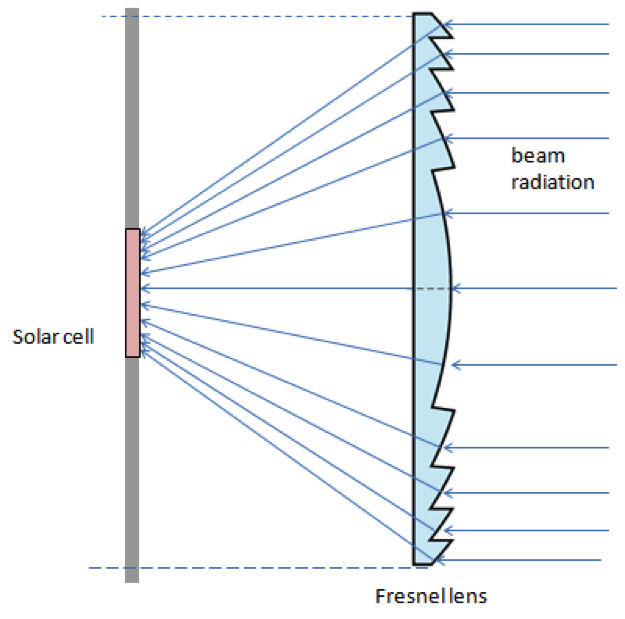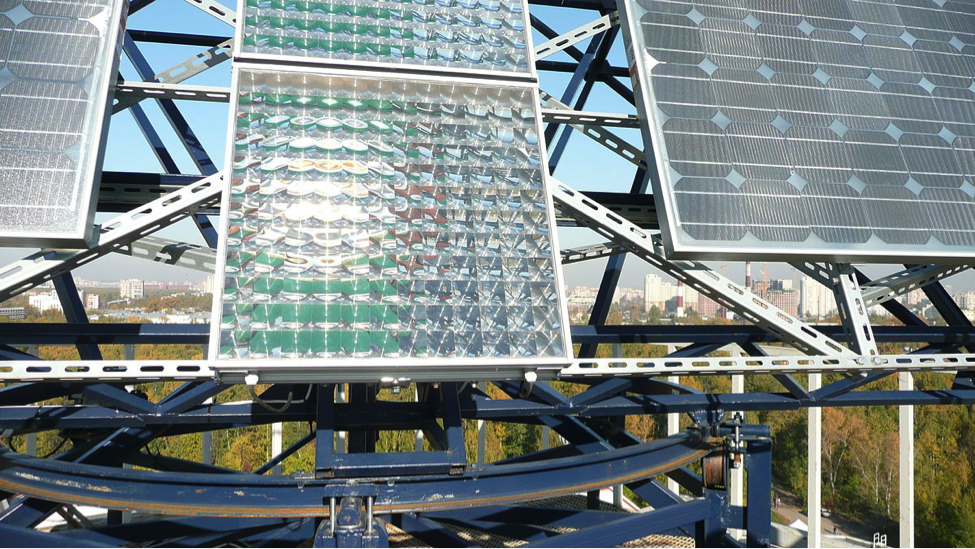5.1. What are concentrating photovoltaics?
One of the ways to increase the output from the photovoltaic systems is to supply concentrated light onto the PV cells. This can be done by using optical light collectors, such as lenses or mirrors. The PV systems that use concentrated light are called concentrating photovoltaics (CPV). The CPV collect light from a larger area and concentrate it to a smaller area solar cell. This is illustrated in Figure 5.1.

Lower efficiency CPV technologies may employ silicon, CdTe, and CIGS (copper indium gallium selenide) cells, but the highest efficiencies can be achieved with multi-junction cells. Field efficiencies for these multi-junction cells are in the 30% range, and laboratory tests have achieved upwards of 40% efficiency (Kurtz, 2011).
The CPV can only use direct beam radiation and cannot use diffuse radiation (diffused from clouds and atmosphere). Therefore, these systems are suited best for areas with high direct normal irradiance. For proper light concentration, sun tracking is needed for achieving high cell performance. Tracking is especially critical for high concentration systems. In general, the CPV can be classified into low-concentration, medium-concentration, and high-concentration.
| Low-concentration | Medium-concentration | High-concentration | |
|---|---|---|---|
| Concentration ratio | 2-10 | 10-100 | 100-400 (and above) |
| PV materials | Silicon | Silicon, CdTe, etc. | Multijunction cells |
| Cooling | not required | Passive cooling | Active cooling |
| Tracking | not required | 1-axis tracking | 2-axis tracking |
The high concentration of sunlight achieved with multijunction cells requires more sophisticated cooling and tracking systems, which can potentially result in higher energy costs.
CPV technology is expected to grow and to expand on market. The cost effectiveness of CPV technology is related to the fact that much smaller sized solar cells are used to convert the concentrated light, which means that much less expensive PV semiconductor material is used. Also, the optics added to the system are made from glass and are usually less expensive than the cells themselves.

| Advantages | Disadvantages |
|---|---|
| Less PV material, hence less cost | With concentrated sunlight, formation of hot spots is possible |
| Increased efficiency | Tracking systems increase complexity |
| Higher productivity throughout the day due to tracking | CPV can properly function only under direct beam radiation |
CPV systems can produce significantly increased temperature on the surface of the PV material, so the energy should be distributed evenly over the cell area to avoid local overheating (hot spots), which can damage the material. Also, the thermodynamic efficiency of the photovoltaic conversion is less at elevated temperatures, so some kind of cooling may be beneficial. Active or passive cooling can be used. For the CPV cells with low and medium concentration ratios, active cooling is not necessary, since the temperatures reached are moderate. The high-concentration cells require high-capacity heat sinks to avoid thermal destruction of the materials.
